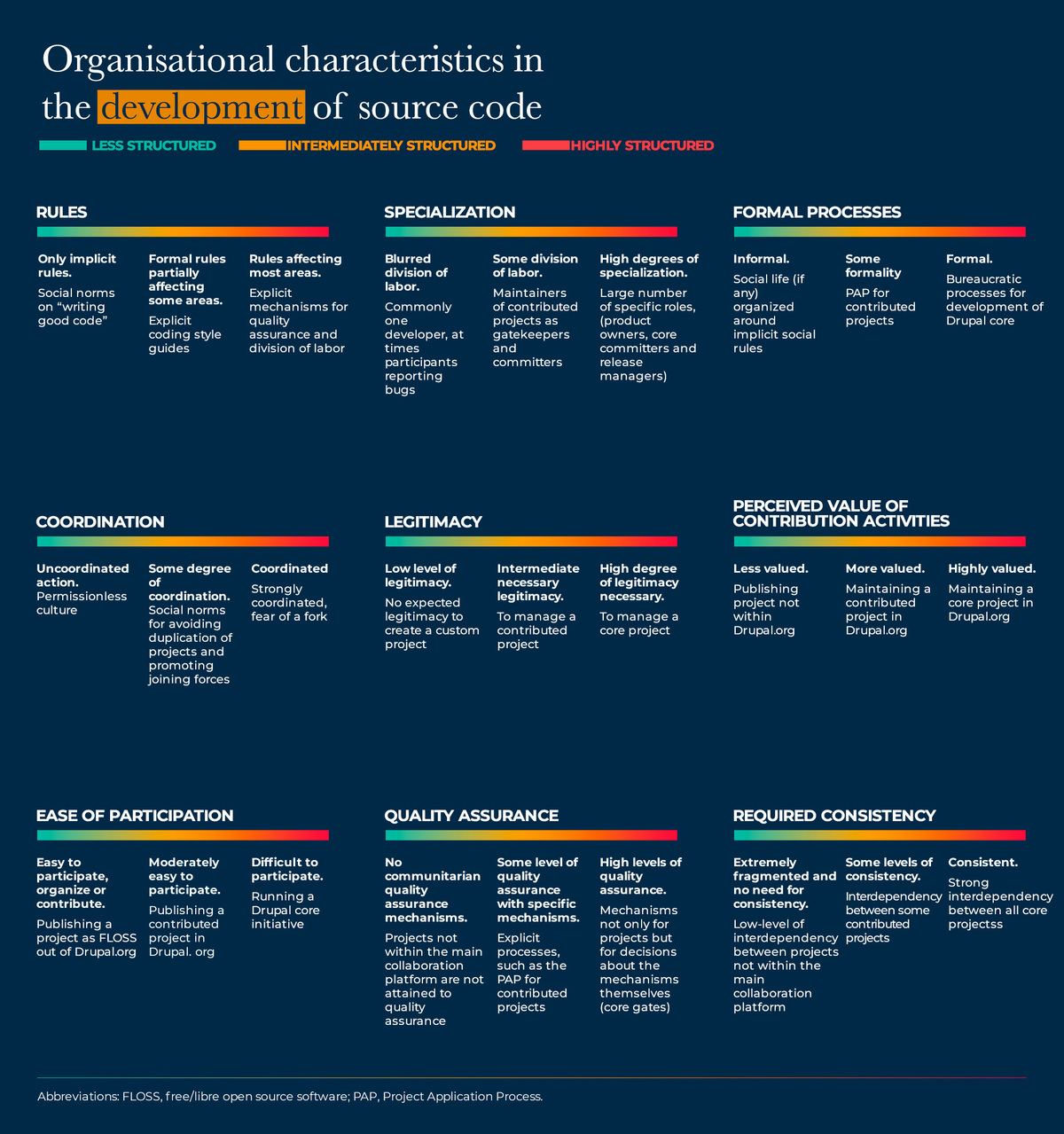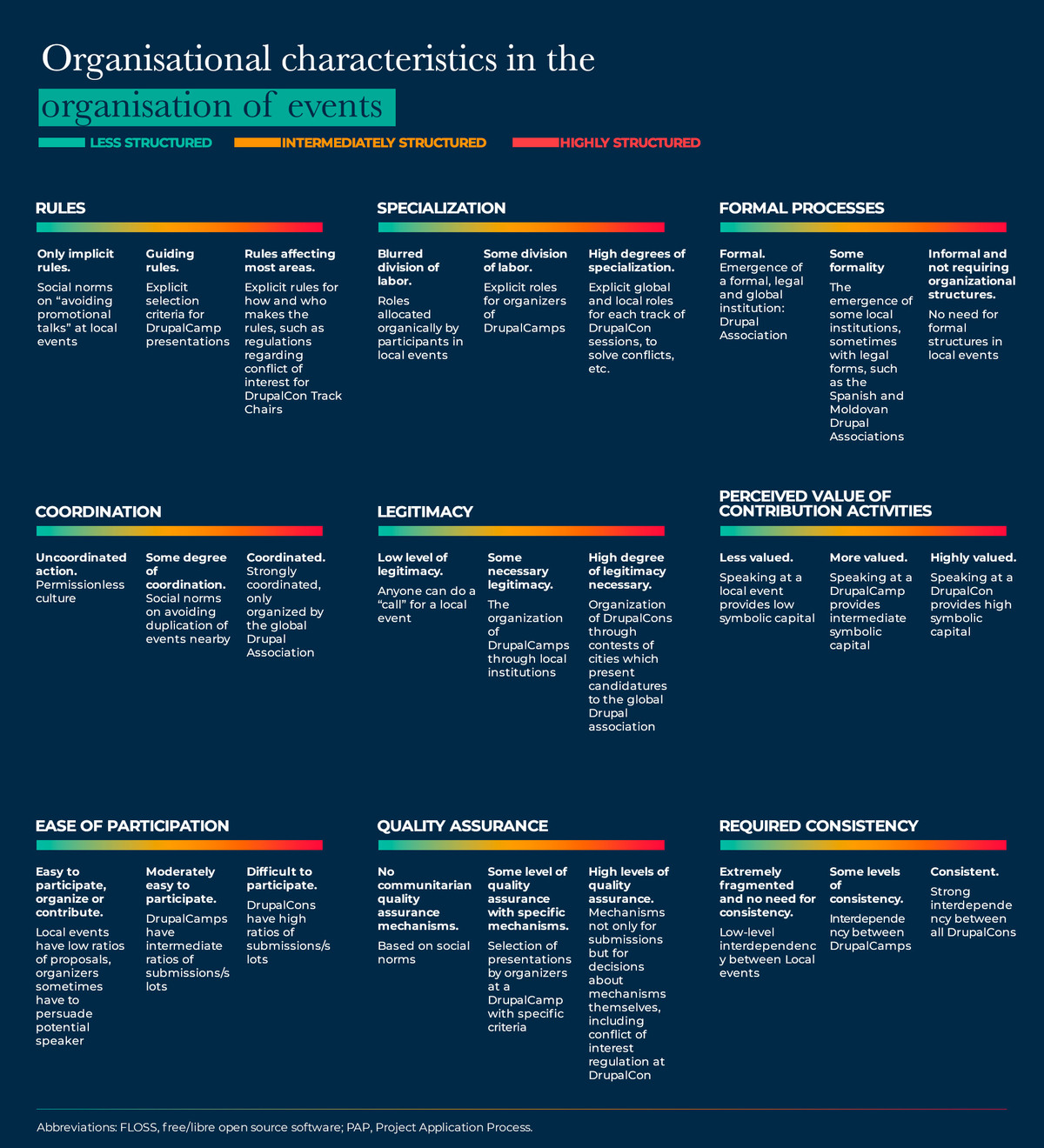One of the main goals of P2P Models is to build Collaborative Economy platforms in which decentralisation does not only mean using a decentralised technology. Our aim is to build platforms in which power and value are also decentralised. In other words, platforms which foster more participatory decision-making processes and in which value is distributed across participants.
Decentralisation of decision-making and formalisation
In collaboration with Steven Huckle (University of Sussex), we have recently published an article in the Journal of the Association for Information Science and Technology in which we explored the relationship between decentralisation of decision-making and formalisation. The chosen community for the study was Drupal. Drupal is a Free Software community supporting the development of a platform that powers approximately 1.5% of websites worldwide. The Drupal community started as a small amateur project in 2001 and has since gathered more than 1.4 million collaborators worldwide. In this article, we studied and compared the evolution of the organisational structures and processes which have emerged around the development of source code and the organisation of face-to-face events. We identified two intertwined dynamics of formalisation and decentralisation of decision-making, resulting in co-existing socio-technical systems that vary in their degrees of organicity.
We also explored the concept of “do-ocracy”, which emerged as one of the categories discussed by Drupalistas when explaining their form of governance. This model involves several practices related to the idea of “bazaar governance” from Free Software studies. That is, Drupalistas “work on what they want to work on, instead of being told what to work on” and in which decision-making is “made through consensus building and based on technical merit, trust and respect”.
“
The picture that emerges of Drupal’s modern‐day organisational processes is characterised by constant negotiation to distribute authority
This “do‐ocratic” model involves blurred and informal organisational processes. At times, this informality becomes a source of tension, for example, once the community grows and tries to scale up their organisational processes. The result is the emergence of more formal and bureaucratic governance processes. “Do‐ocracies” are in contrast to the more traditional “cathedral‐style” governance model, which is characterised by top‐down forms of organisation. Thus, if we are to develop on the classic metaphors in Free Software studies of “The bazaar and the cathedral”, this study shows how Drupal hybridises both: revealing a continuum of degrees of organicity rather than a dichotomy between mechanistic and organic organisational forms.
The picture that emerges of Drupal’s modern‐day organisational processes is characterised by constant negotiation to distribute authority. As a result, several socio-technical systems shaped by the intertwined dynamics of formalisation and decentralisation of decision-making have emerged. Drupal’s organisational structures distribute authority to scale up decision-making, so that participants in Commons-Based Peer Production (CBPP) processes in these common property regimes “have authority to make at least some of the rules related to the use of that particular resource”, in congruence with Ostrom’s notion of polycentrism.
Conceptual frameworks employed in the study
The study draws conceptually on Engeström’s Activity Theory and on Burns and Stalker’s classic concepts of organic and mechanistic organisational structures.
Through the application of Activity Theory, we explore the relationships between the different entities involved in the activities related to the development of source code and the organisation of face-to-face events, providing the means to avoid simple monocausal explanations to explore the emergence of socio-technical systems.
The result of this analysis is the identification of a set of common organisational characteristics in a sizable case of CBPP such as Drupal. Higher degrees of formalisation and centralisation characterise mechanistic structures. In mechanistic structures, processes are more bureaucratic and rigid; there are more explicit divisions of labour, and decision-making follows a more top‐down hierarchy. In contrast, organic organisational structures have higher degrees of informality and decentralisation. They lack rigid procedures and involve lower levels of specialisation. If a division of labour is apparent at all, it is blurred, and specific needs drive the decision‐making processes.
In sum, this study shows how the growth experienced by Drupal has resulted in a general dynamic of decentralised decision-making to distribute authority, which involved a general dynamic of formalisation of organisational processes. The result has been the emergence of several socio-technical systems varying in their degrees of organicity which, while remaining oriented to a similar focus from an Activity Theory perspective, source code and events, simultaneously interact and co-exist. To manage these, Drupal has developed various organisational forms. The most formal systems ensure the successful execution of activities requiring the highest levels of coordination, consistency and quality assurance. Often this formalisation is counterbalanced by decentralised, autonomous organisational forms that are fertile grounds for experimentation and innovation.


Set of conclusions
Finally, the article provides a set of recommendations for CBPP practitioners, on the basis of the exploration of Drupal as a case study:
- The simultaneous coexistence of several systems with different degrees of organicity focused on similar goals is sometimes perceived as inefficient and redundant by participants in CBPP communities
- This coexistence is, however, useful to develop a certain equilibrium (formal/informal, global/local, or centralised/decentralised) within the dynamics of the community
- CBPP communities should identify and embrace the coexistence of these various organisational forms in the community
- CBPP institutions should assume organisational change as part of the day‐to‐day, rather than taking a position of resistance
- A key aspect for CBPP practitioners is to consider the need to create the conditions that enable the distribution of authority among several centres of governance that might emerge in communitarian networks as CBPP communities grow
- Rather than opting for imposing certain conditions from a position of central authority, the role of CBPP’s institutions should involve providing ways to coordinate the emergence and outcomes of these communitarian networks. For example, in a federative manner: acting as an umbrella for communitarian initiatives
- CBPP practitioners should consider the relevance of the offline medium to grow and sustain the health of the community. When growing in size and complexity, they should also try to envision ways to foster these interactions at several levels in order to scale‐up the sense of community.
Read the full article here.
AUTHOR

[icon name=”twitter” class=”” unprefixed_class=””] David Rozas
Geeky Sociologist
The authorship is by David Rozas Domingo, but this content has been made thanks to the whole P2P Models team ![]()
The designs are by Elena Martinez
The review by Genoveva López and Tabitha Whittall
The research has been carried out by David Rozas
Samer Hassan and Rosa Chamorro make everything possible





